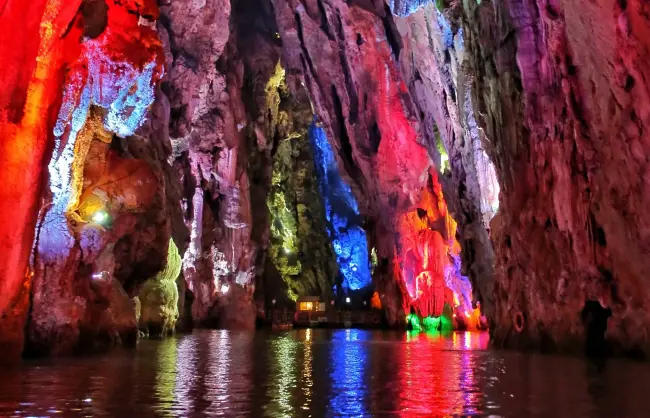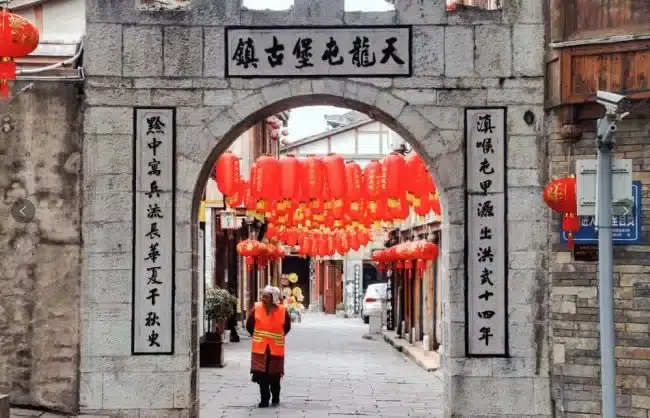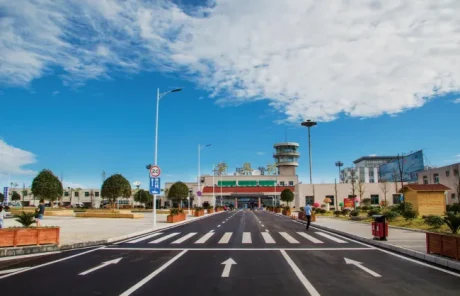Anshun Travel Guide
Located in the south of Guizhou Province, Anshun is assuredly a land that is blessed with stunning natural landscapes and rich ethnic culture.
This region is dominated by karst landforms and is known for its abundant captivating limestone peaks, stone forests, underground rivers, cascading waterfalls, lush greenery, and intricate gorges and caves. The world-renowned Huangguoshu Waterfall, the largest waterfall in Aisa, is the prime representative of its natural beauty. Besides that, the fantastic limestone formations in Tianxingqiao Scenic Area, intricate stalactite formations and underground chambers in Dragon Palace Cave, and limestone cliffs, karst formations, and crystal-clear rivers all add charm to the city’s natural beauty.
Beyond the diverse natural wonders, Anshun also boasts a rich ethnic culture and rich historical heritage, influenced by its diverse ethnic minority groups, such as Buyi, Miao, and Gelao. Ethnic minorities make up 41.9% of its total population and have well-preserved their unique traditions, customs, and architecture. For example, in Tianlong Tunpu, people still preserve the traditional Ming lifestyle, stone houses, hairstyles, clothes, and traditional Dixi Drama. You’ll also get a chance to witness the stone architecture and batik art of the Buyi people and learn about their unique folklore and traditions.

Chinese: 安顺 ān shùn
Location: Midwest Guizhou
Population (urban area): 2,455,500
Why Visit Anshun
- Anshun is endowed with stunning karst geology with the landscape being dotted with eye-catching mountains, caves, gorges, underground rivers, and waterfalls.
- Anshun is a place of a variety of ethnic minority groups, offering a glimpse into the authentic ethnic culture and heritages.
- Anshun offers a rare chance to witness ancient Han culture in Tianlong Tunpu where people still practice the lifestyle and custom of the Ming Dynasty.
Top Attractions in Anshun
Top Things to Do in Anshun
Marvel at the Spectacular Huangguoshu Waterfall
The landmark of Anshun and Guizhou, Huangguoshu Waterfall is the largest waterfall in Asia, boasting a height of 77.8 meters, and a width of 101 meters. It’s truly a spectacular scenery with the water cascading down from the high above, and being surrounded by lush forests and stunning lakes. Around the waterfall, there are several viewing stages, allowing visitors the admire its wonder from different angles. Best of all, viewers can enter the 134-meter-long Water-curtain Cave behind the waterfall and get a rare chance to admire the waterfall from behind and even touch the water. It is recommended to visit the waterfall during the rainy season from June to August when the waterfall is more spectacular. And besides the Huangguoshu Waterfall, there are 18 other waterfalls and awe-inspiring karst landscapes in this area waiting to uncover its endless beauty for you.

Explore Dragon Palace Cave
With many karst caves linked by a long underground river, the Dragon Palace Cave is just like the palace of the Dragon King in the folktales, hence its name. The river stretches about 5,000 meters, connecting a complex network of 90 karst caves. You can hop on a boat to sail through this longest underground river in China, and marvel at a series of stalactites, stalagmites, columns, curtains, and stone forests that are illuminated by colorful lights. Besides the boat ride sightseeing, Longmen Waterfall should be another highlight of the Dragon Palace Cave. With a height of 38 meters and a width of 25 meters, this largest in-cave waterfall will offer you a spectacular sight and great photo opportunities.

Experience the Ancient Tunpu Culture in Tianlong Tunpu
With its history tracing back to over 600 years ago in the Ming Dynasty, Tianlong Tunpu is a fortified village that stands as an exceptional example of ancient Chinese architecture and military defense. The village is a world of stone, with all of its architecture being built entirely of stone, impressing visitors with stone walls, stone roofs, stone watchtowers, stone crenels, and stone roads.

It is said that the Tunpu people in the village are the descendants of a Han troop in the Ming Dynasty who were sent to Anshun to guard the border and suppress the local rebellions. Relatively closed to the outside world, the village preserved its culture, customs, and lifestyle for over 600 years. Nowadays, locals still wear their traditional costumes and hairstyles, practice their unique martial arts, and speak their ancient language. Wandering along the stone-paved road in Tianlong Tunpu, you may still encounter local women embroidering flower shoes on the street for sale.
Discover the Landscape of Getu River National Park
Getu River National Park is a ca n’t-miss for those who seek an adventure in nature. Covering an area of over 1,200 square kilometers, the park is home to hundreds of karst caves, mountains, limestone cliffs, crystal-clear rivers, and lush forests. During a visit here, you will not only be rewarded with unforgettable sightseeing but also many thrilling outdoor activities, such as hiking, rock climbing, and bamboo rafting. Moreover, you’ll also get a chance to experience the culture of Miao ethnic people who live in the area and watch the intangible cultural displays of Miao spidermen climbing rocks with bare hands.
Learn about the Culture of the Buyi Ethnic Minority in Stone Village
Located in the Huangguoshu Waterfall Scenic Area, Stone Village is a Buyi village offering a glimpse into The Buyi’s distinctive architectural style, beliefs, traditional crafts, and arts. In the village, all the houses, walls, bridges, and roads are built with stones and slate. The Buyi in this area have preserved their traditions and customs for thousands of years, and are famous for their wax painting, batik, brocade, and indigo-dyed clothes.
Anshun Weather
Anshun is located on the eastern part of the Yunnan-Guizhou Plateau, enjoying a plateau-type humid subtropical monsoon climate. It features warm and rainy summers and mild and dry winters, with the annual average temperature hovering between 12.7-16 .2℃. January is the coldest month in Anshun when the temperatures run between 3-6℃. July is its hottest month, with the average temperatures staying around 22.3-23 .6℃. Anshun rarely sees extreme temperatures, enjoying comfortable weather for about 10 months throughout the year. June to August is usually the best time to visit Anshun when the rainy season brings the most spectacular scenery of Huangguoshu Waterfall.
Anshun Transportation
How to get to Anshun?
By air:
Visitors can fly to Anshun Huangguoshu Airport which operates flights to/off major domestic cities, such as Beijing, Shanghai, Hangzhou, Lijiang, Nanchang, Zhuhai. The airport is about 6 km from the city center, you can either take a taxi or airport shuttle bus to get to the city center.
By Train:
Anshun West Railway Station operates many high-speed trains to/off cities along the Shanghai-Kunming high-speed railway and Anshun-Liupanshui high-speed railway.
By taxi: You can either hail a taxi on the street or use Didi Chuxing, the flagfall is CNY 7 for the first 3 km, then the price is 0.8 yuan per car/500 meters.
By bus: 15 bus lines in Anshun can take you to most attractions conveniently. Also, there are two long-distance bus stations – the South Bus Station and the West Bus Station, which operate direct buses to nearby cities and attractions, such as Guiyang, Guiyang, Getu River, etc.

Our Top Guizhou Tours Including Anshun:
4 Days Guizhou Highlights Tour with Huangguoshu
6 Days Guizhou Tour of Guiyang Kaili Fanjingshan









